Oral Administration of Lactobacillus Casei Expressing Flagellin A Protein Confers Effective Protection against Aeromonas Veronii in Common Carp, Cyprinus Carpio
Abstract
1. Introduction
2. Results
2.1. Construction of the Recombinant L. casei
2.2. Western Blotting
2.3. Surface Expression of the Modified FlaA
2.4. Humoral Immune Parameters
2.5. Expression of Immune-Related Genes
2.6. Colonization of Recombinant L. casei in the Fish Intestine
2.7. Challenge Test
3. Discussion
4. Materials and Methods
4.1. Fish and Ethics Statement
4.2. Bacterial Strains, Plasmids and Growth Conditions
4.3. Construction of Recombinant L. casei Expressing FlaA Gene
4.4. Western Blotting Assay
4.5. Expression of FlaA on the Cell Surface
4.6. Oral Immunization and Sample Collection
4.7. Phagocytic Activity of Leukocyte
4.8. Enzyme-Linked Immunosorbent Assay (ELISA)
4.9. Real-Time PCR Analysis
4.10. Colonization of Recombinant L. casei in the Fish Intestine
4.11. Challenge Test
4.12. Data Analysis
5. Conclusions
Author Contributions
Funding
Conflicts of Interest
References
- Havixbeck, J.J.; Rieger, A.M. Neutrophils exert protection in early, Aeromonas veronii, infections through the clearance of both bacteria and dying macrophages. Fish Shellfish Immunol. 2017, 67, 18–30. [Google Scholar] [CrossRef] [PubMed]
- Parker, J.L.; Shaw, J.G. Aeromonas spp. clinical microbiology and disease. J. Infect. 2011, 62, 109–118. [Google Scholar] [CrossRef] [PubMed]
- Janda, J.M.; Abbott, S.L. The genus Aeromonas taxonomy, pathogenicity, and infection. Clin. Microbiol. Rev. 2010, 23, 35–73. [Google Scholar] [CrossRef]
- Jagoda, S.S.S.; De, S.; Honein, K. Genome sequencing and annotation of Aeromonas veronii strain Ae52, a multidrug-resistant isolate from septicaemic gold fish (Carassius auratus) in Sri Lanka. Genom. Data 2017, 11, 46–48. [Google Scholar] [CrossRef] [PubMed]
- Abolghait, S.K.; Mohamed, M.K. Attenuated virulence of pigment-producing mutant of Aeromonas veronii bv. sobria in HeLa cells and Nile tilapia (Oreochromis niloticus). Int. J. Vet. Sci. Med. 2013, 1, 43–47. [Google Scholar] [CrossRef][Green Version]
- Martha, R.B.; Carlos, A. Humoral immune response and TLR9 gene expression in Pacific red snapper (Lutjanus peru) experimentally exposed to Aeromonas veronii. Fish Shellfish Immunol. 2015, 42, 289–296. [Google Scholar]
- Chen, J.S.; Zhu, N.Y. First case of soft shell disease in Chinese soft-shelled turtle (Trionyx sinens) associated with Aeromonas sobria–A. veronii complex. Aquaculture 2013, 25, 62–63. [Google Scholar] [CrossRef]
- Hickmanbrenner, F.W.; MacDonald, K.L. Aeromonas veronii, a new ornithine decarboxylase-positive species that may cause diarrhea. J. Clin. Microbiol. 1987, 25, 900–906. [Google Scholar]
- Yang, B.T.; Zhang, D.X. Maltoporin (LamB protein) contributes to the virulence and adhesion of Aeromonas veronii TH0426. J. Fish Dis. 2019, 42, 379–389. [Google Scholar] [CrossRef]
- Pridgeon, J.W.; Klesius, P.H. Molecular identification and virulence of three Aeromonas hydrophila isolates cultured from infected channel catfish during a disease outbreak in west Alabama (USA) in 2009. Dis. of Aquat. Org. 2011, 94, 249–253. [Google Scholar] [CrossRef]
- Silva, B.C.; Mourino, J.L.P. Haemorrhagic septicaemia in the hybrid surubim (Pseudoplatystoma corruscans × Pseudoplatystoma fasciatum) caused by Aeromonas hydrophila. Aquac. Reseacher 2012, 43, 908–916. [Google Scholar] [CrossRef]
- Dhar, A.K.; Manna, S.K. Viral vaccines for farmed finfish. Virus Disease. 2014, 25, 1–17. [Google Scholar] [CrossRef] [PubMed]
- Li, P.; Gatlin, D.M. Evaluation of brewers yeast (Saccharomyces cerevisiae) as a feed supplement for hybrid striped bass (Morone chrysops × M. saxatilis). Aquaculture 2003, 219, 681–692. [Google Scholar] [CrossRef]
- Goncaves, A.T.; Valentina, V. Intestinal transcriptome modulation by functional diets in rainbow trout: A high-throughput sequencing appraisal to highlight GALT immunomodulation. Fish Shellfish Immunol. 2017, 64, 325–328. [Google Scholar] [CrossRef] [PubMed]
- Xia, Y.; Cao, J.M. Effects of Lactococcus lactis subsp. lactis JCM5805 on colonization dynamics of gut microbiota and regulation of immunity in early ontogenetic stages of Tilapia. Fish Shellfish Immunol. 2019, 86, 53–56. [Google Scholar] [CrossRef]
- Zhao, L.L.; Liu, M. Expression of infectious pancreatic necrosis virus (IPNV) VP2-VP3 fusion protein in Lactobacillus casei and immunogenicity in rainbow trouts. Vaccine 2012, 30, 1823–1829. [Google Scholar]
- Hayashi, F.; Smith, K.D. The innate immune response to bacterial flagellin is mediated by Toll-like receptor 5. Nature 2001, 410, 1099–1103. [Google Scholar] [CrossRef]
- Song, M.F.; Kang, Y.H. Immunogenicity of extracellular products from an inactivated vaccine against Aeromonas veronii TH0426 in koi, Cyprinus carpio. Fish Shellfish Immunol. 2018, 81, 176–181. [Google Scholar] [CrossRef]
- Yang, Q.; Zhao, M. Multidrug-Resistant Aeromonas veronii Recovered from Channel Catfish (Ictalurus punctatus) in China: Prevalence and Mechanisms of Fluoroquinolone Resistance. Microb. Drug Resist. 2016, 23, 473–479. [Google Scholar] [CrossRef]
- Kanellos, T.; Sylvester, I.D. DNA vaccination can protect Cyprinus Carpio against spring Viraemia of carp virus. Vaccine 2006, 24, 4927–4933. [Google Scholar] [CrossRef]
- Emmenegger, E.J.; Kurath, G. DNA vaccine protects ornamental koi (Cyprinuscarpio koi) against North American spring viremia of carp virus. Vaccine 2008, 26, 6415–6421. [Google Scholar] [CrossRef] [PubMed]
- Ning, J.F.; Zhu, W. Oral delivery of DNA vaccine encoding VP28 against white spot syndrome virus in crayfish by attenuated Salmonella typhimurium. Vaccine 2009, 27, 1127–1135. [Google Scholar] [CrossRef] [PubMed]
- Cui, L.C.; Guan, X.T. Recombinant lactobacillus expressing G protein of spring viremia of carp virus (SVCV) combined with ORF81 protein of koi herpesvirus (KHV): A promising way to induce protective immunity against SVCV and KHV infection in cyprinid fish via oral vaccination. Vaccine 2015, 33, 3092–3099. [Google Scholar] [CrossRef] [PubMed]
- Daniela, G.; Oriol, S.J. The mucosal immune system of fish: The evolution of tolerating commensals while fighting pathogens. Fish Shellfish Immunol. 2013, 35, 1729–1739. [Google Scholar]
- Canals, R.; Altarriba, M. Analysis of the lateral flagellar gene system of Aeromonas hydrophila AH-3. J. Bacteriol. 2006, 188, 852–862. [Google Scholar] [CrossRef]
- Canals, R.; Silvia, M. Polar flagellum biogenesis in Aeromonas hydrophila. J. Bacteriol. 2006, 188, 542–555. [Google Scholar] [CrossRef]
- Rabaan, A.A.; Gryllos, I. Motility and the polar flagellum are required for Aeromonas caviae adherence to HEp-2 cells. Infect. Immun. 2001, 69, 4257–4267. [Google Scholar] [CrossRef]
- Hajam, I.A.; Dar, P.A. Bacterial flagellin-a potent immunomodulatory agent. Exp. Mol. Med. 2017, 49, e373. [Google Scholar] [CrossRef]
- Zhao, Y.; Shao, F. The NAIP-NLRC4 inflammasome in innate immune detection of bacterial flagellin and type III secretion apparatus. Immunol. Rev. 2015, 265, 85–102. [Google Scholar] [CrossRef]
- Jiang, J.; Zhao, W. Immune responses of channel catfish following the stimulation of three recombinant flagellins of Yersinia ruckeri in vitro and in vivo. Dev. Comp. Immunol. 2017, 73, 61–71. [Google Scholar] [CrossRef]
- Hoseinifar, S.H.; Roosta, Z. The effects of Lactobacillus acidophilus as feed supplement on skin mucosal immune parameters, intestinal microbiota, stress resistance and growth performance of black swordtail (Xiphophorus helleri). Fish Shellfish Immunol. 2015, 42, 533–538. [Google Scholar] [CrossRef] [PubMed]
- Sen, S.S. Effect of cellular products of potential probiotic bacteria on the immune response of Labeo rohita and susceptibility to Aeromonas hydrophila infection. Fish Shellfish Immunol. 2015, 46, 716–722. [Google Scholar]
- Guardiola, F.A.; Bahi, A. Effects of dietary supplementation with fenugreek seeds, alone or in combination with probiotics, on gilthead seabream (Sparus aurata L.) skin mucosal immunity. Fish Shellfish Immunol. 2017, 65, 169–178. [Google Scholar] [CrossRef] [PubMed]
- Edward, A.M.; Erica, A.N. TLR5 and Ipaf: Dual sensors of bacterial flagellin in the innate immune system. Semin. Immunopathol. 2007, 29, 275–288. [Google Scholar]
- Tu, X.; Qi, X.Z. Cytokine gene expression profiles in goldfish (Carassius auratus) during Gyrodactylus kobayashii infection. Fish Shellfish Immunol. 2019, 86, 116–124. [Google Scholar] [CrossRef] [PubMed]
- Cutrullis, R.A.; Petray, P.B. MIF-driven activation of macrophages induces killing of intracellular Trypanosoma cruzi dependent on endogenous production of tumor necrosis factor, nitric oxide and reactive oxygen species. Immunobiology 2016, 222, 423–431. [Google Scholar] [CrossRef]
- Gewirtz, A.T.; Navas, T.A. Cutting edge: Bacterial flagellin activates basolaterally expressed TLR5 to induce epithelial proinflammatory gene expression. J. Immunol. 2001, 167, 1882–1885. [Google Scholar] [CrossRef]
- Moore, K.W.A.; O’Garra, A. Interleukin-10. Annu. Rev. Immunol. 1993, 11, 165–190. [Google Scholar] [CrossRef]
- Moore, K.W.A.; O’Garra, A. Interleukin-10 and the interleukin-10 receptor. Annu. Rev. Immunol. 2001, 19, 683–765. [Google Scholar] [CrossRef]
- Biswas, G.; Korenaga, H. Cytokine responses in the Japanese pufferfish (Takifugu rubripes) head kidney cells induced with heat-killed probiotics isolated from the Mongolian dairy products. Fish Shellfish Immunol. 2013, 34, 1170–1177. [Google Scholar] [CrossRef]
- Shigemori, S.; Watanbe, T. Oral delivery of Lactococcus lactis that secretes bioactive heme oxygenase-1 alleviates development of acute colitis in mice. Microb. Cell Factories 2015, 14, 189–200. [Google Scholar] [CrossRef] [PubMed]
- Cheung, Q.C.; Yuan, Z. Generation of epidermal growth factor-expressing Lactococcus lactis and its enhancement on intestinal development and growth of early-weaned mice. Am. J. Clin. Nutr. 2009, 89, 871–879. [Google Scholar] [CrossRef] [PubMed]
- Safari, R.; Hoseinifar, S.H. Apple cider vinegar boosted immunomodulatory and health promoting effects of Lactobacillus casei in common carp (Cyprinus carpio). FishShellfish Immunol. 2017, 67, 441–448. [Google Scholar] [CrossRef] [PubMed]
- Zhang, D.X.; Kang, Y.H. Oral immunization with recombinant Lactobacillus casei expressing OmpAI confers protection against Aeromonas veronii challenge in common carp, Cyprinus carpio. Fish Shellfish Immunol. 2018, 72, 552–563. [Google Scholar] [CrossRef] [PubMed]
- Kang, Y.H.; Pan, X.Y. Complete genome sequence of the fish pathogen Aeromonas veronii TH0426 with potential application in biosynthesis of pullulanase and chitinase. J. Biotechnol 2016, 227, 81–82. [Google Scholar] [CrossRef] [PubMed]
- Hou, X.L.; Yu, L.Y. Surface-displayed porcine epidemic diarrhea viral (PEDV) antigens on lactic acid bacteria. Vaccine 2007, 26, 24–31. [Google Scholar] [CrossRef]
- Xu, Y.G.; Guan, X.T. Immunogenicity in swine of orally administered recombinant Lactobacillus plantarum expressing classical swine fever virus E2 protein in conjunction with Thymosin α-1 as an adjuvant. Appl. Environ. Microbiol. 2015, 81, 3745–3752. [Google Scholar] [CrossRef]
- Alimolaei, M.; Golchin, M. Orally administered recombinant Lactobacillus casei vector vaccine expressing β-toxoid of Clostridium perfringens that induced protective immunity responses. Res. Vet. Science. 2017, 115, 332–339. [Google Scholar] [CrossRef]
- Avtalion, R.R.; Shahrabani, R. Studies on phagocytosis in fish. I. In vitro uptake and killing of living Staphylococcus aureus by peripheral leucocytes of carp (Cyprinus carpio). Immunology 1975, 29, 1181–1187. [Google Scholar]

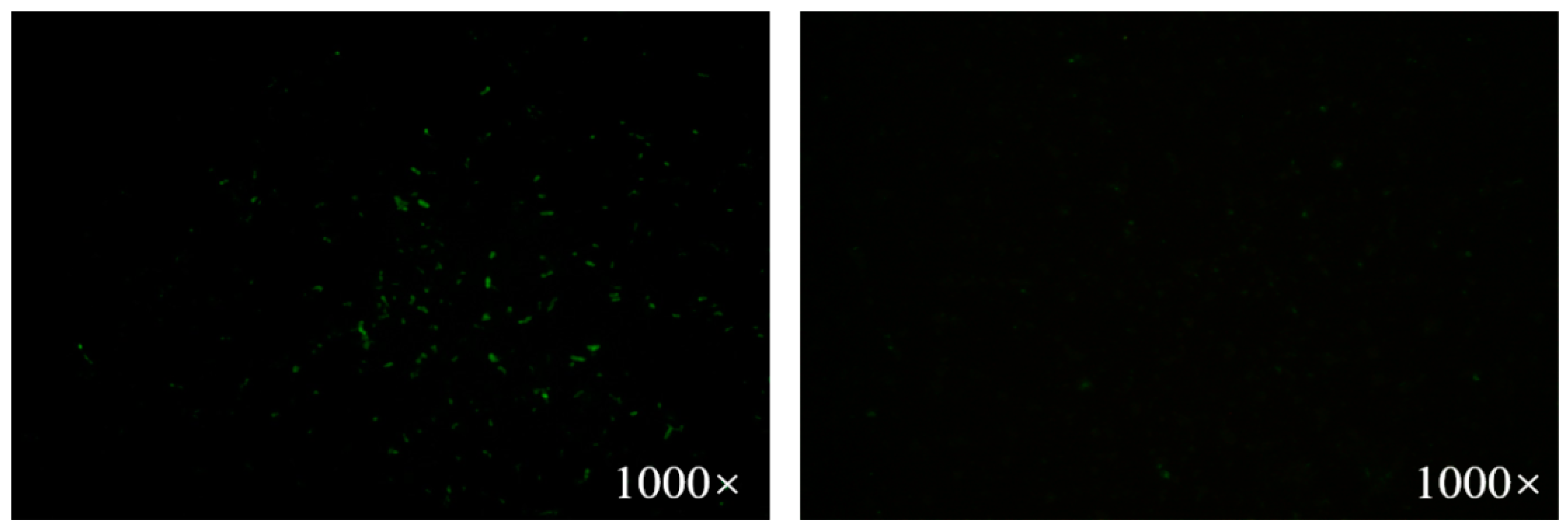

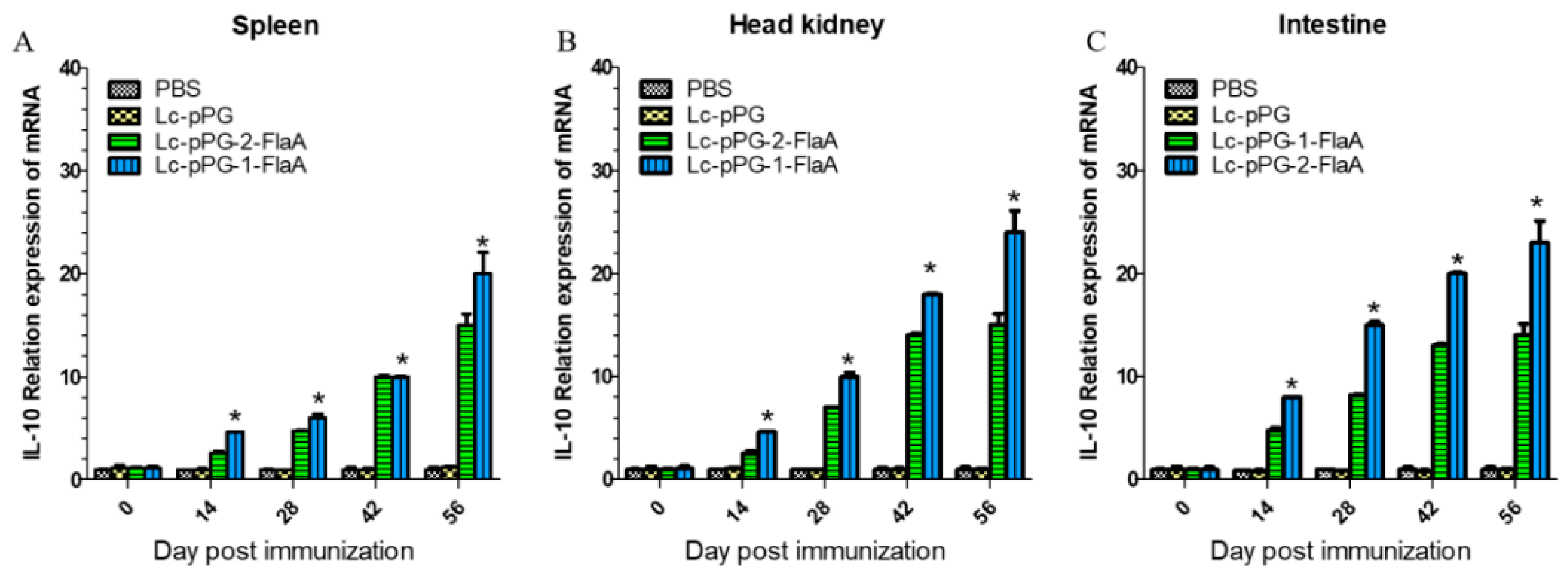

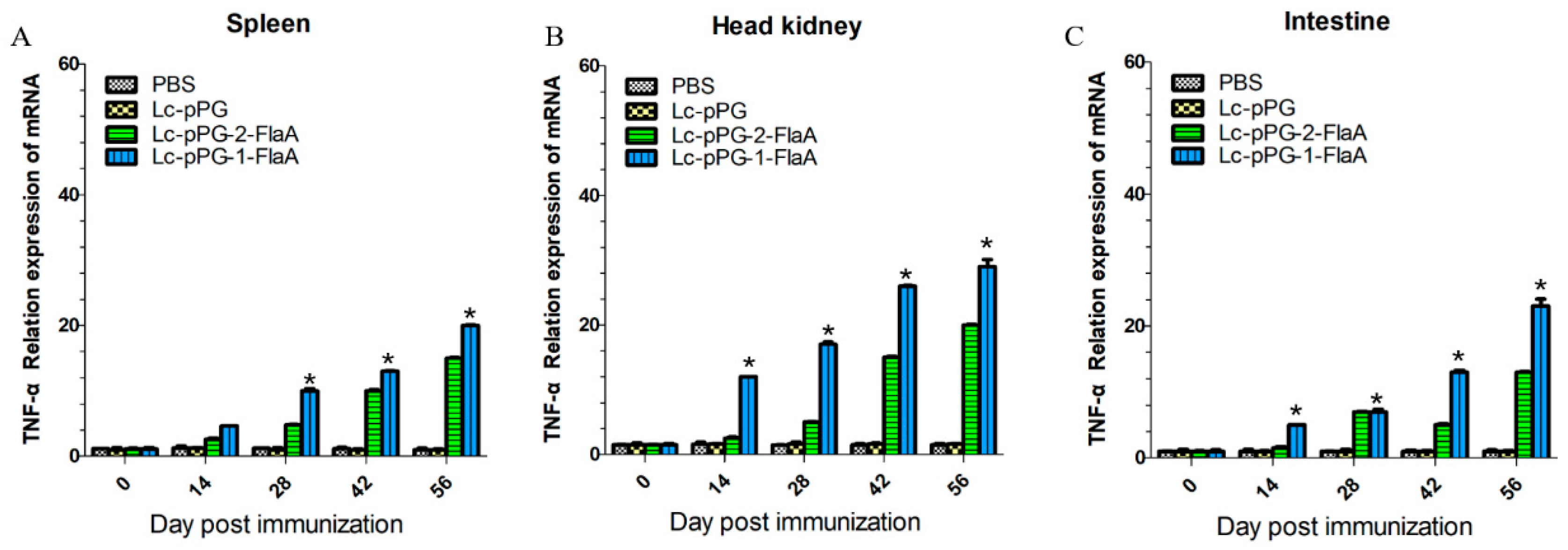
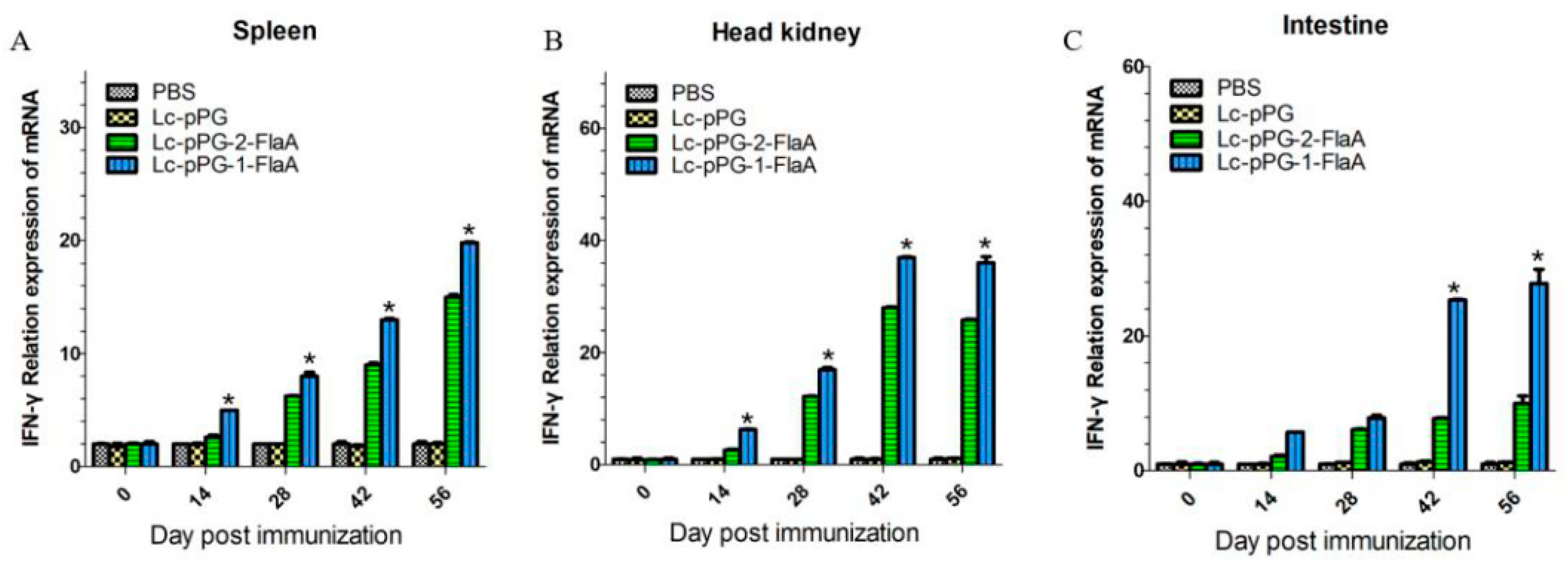
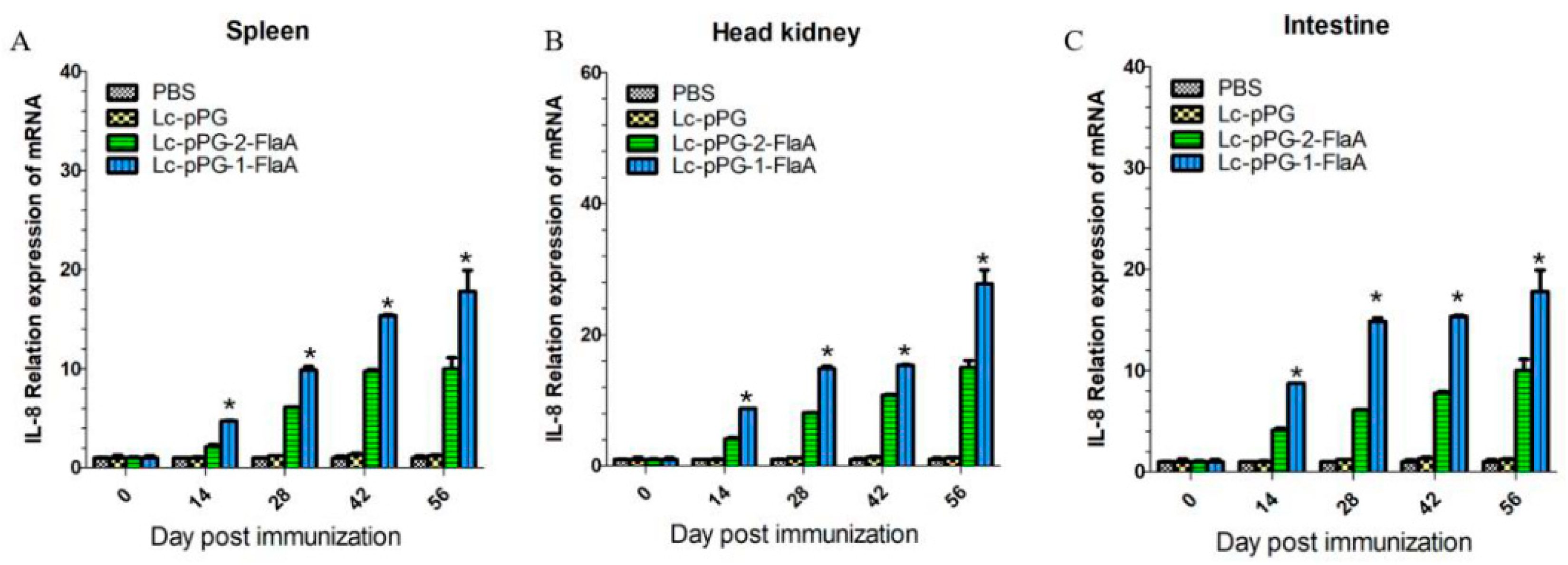
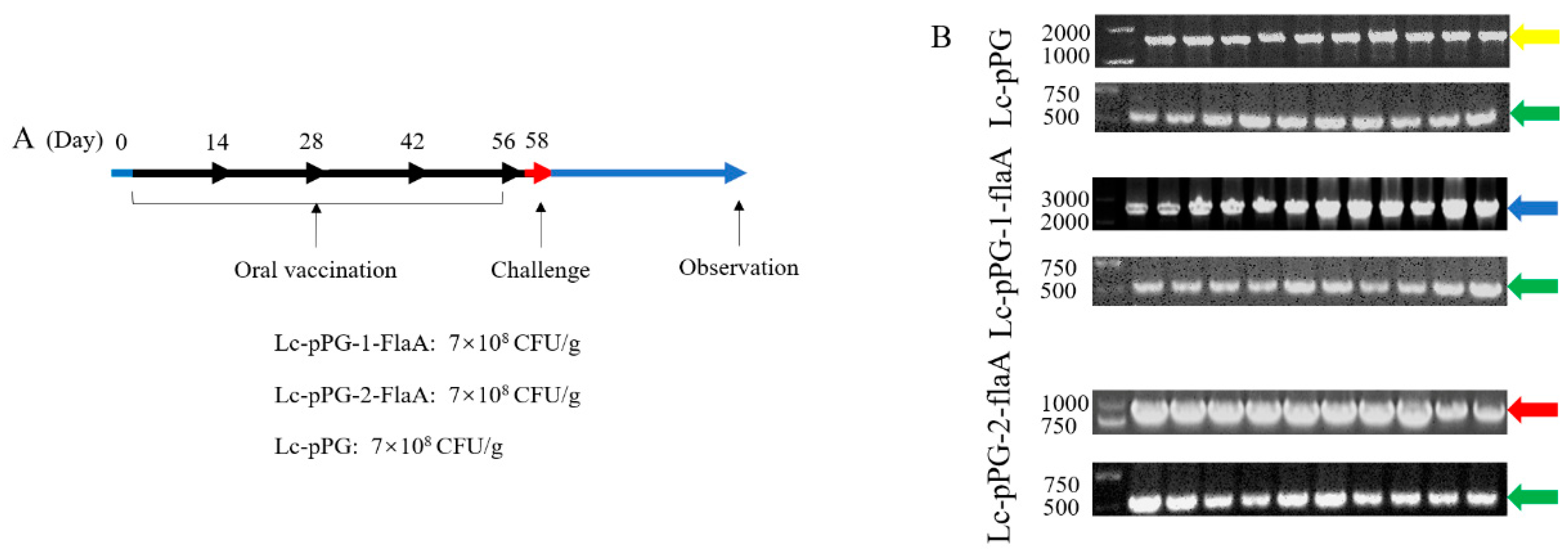
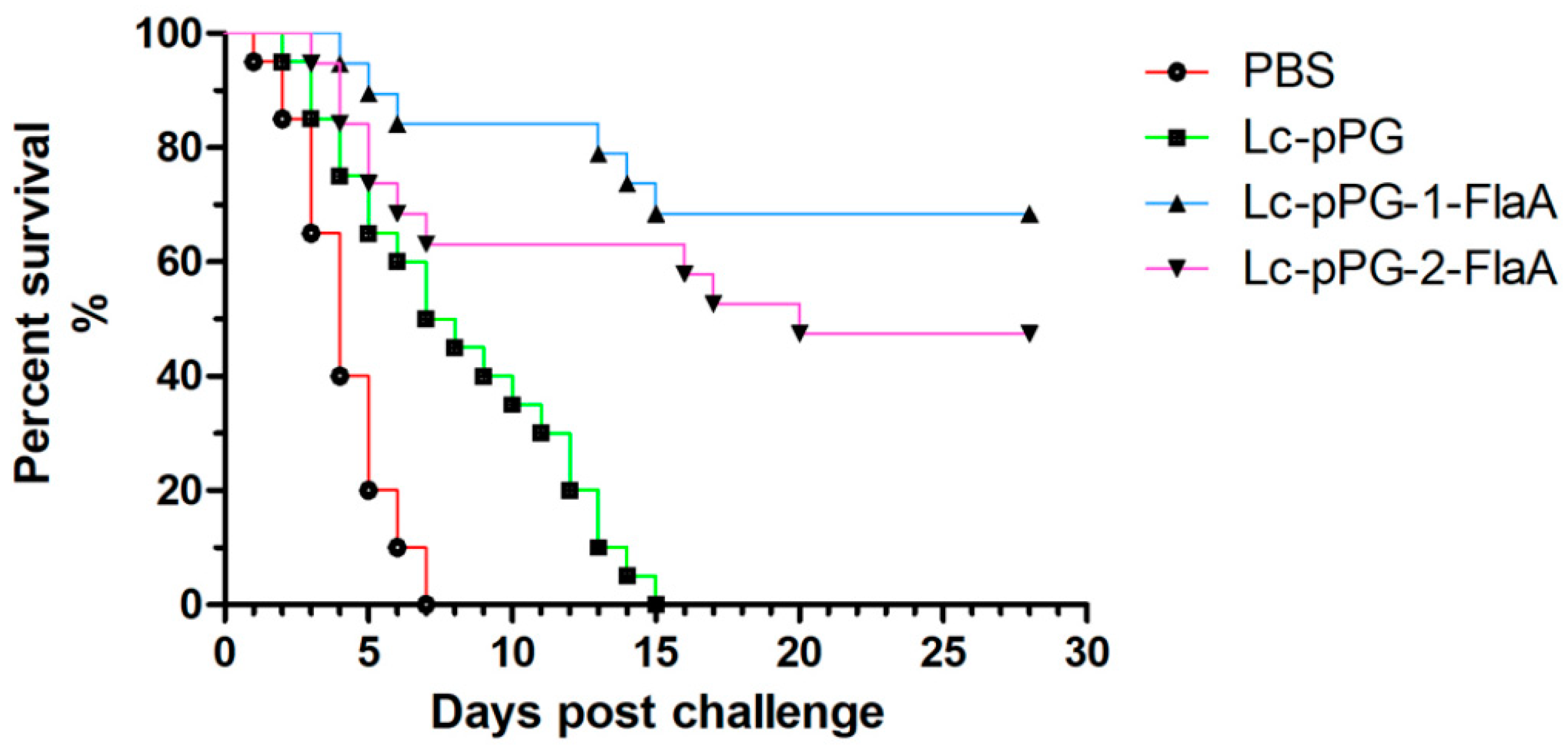
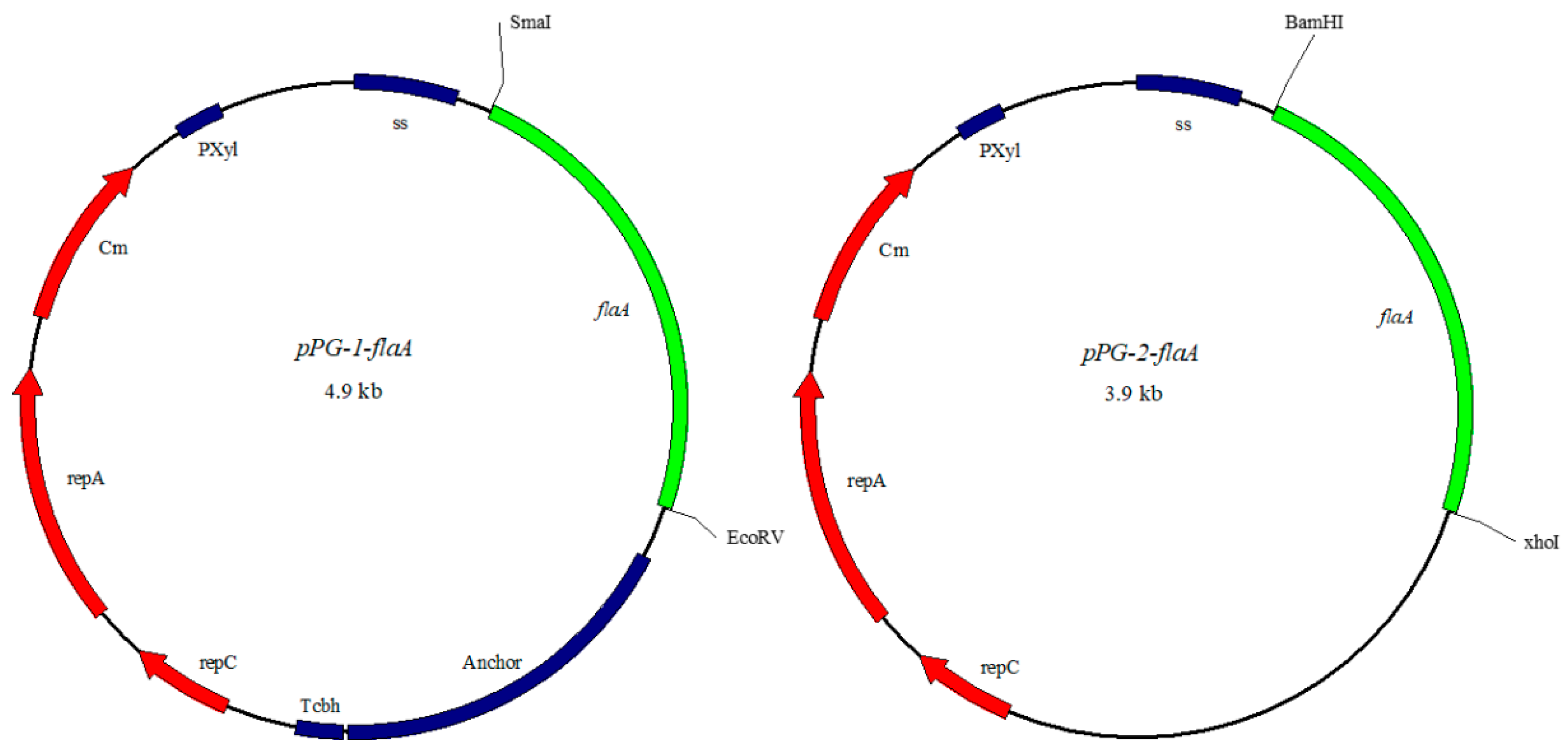
| Primer | Sequence(5’-3’) | Accession | PCR Product (bp) |
|---|---|---|---|
| IL-8 | F: CATTCAGAGCCAGCAATT | AB470924.1 | 135 |
| R: CACCCAGTCTTTAGTAGGAT | |||
| IL-10 | F: AACTGATGACCCGAATGGAAAC | JX524550.1 | 143 |
| R: CACCTTCTCCCAGTCGTCAAA | |||
| IL-1β | F: CATCAAAGAAATCGCTCCTG | AB010701 | 133 |
| R: GCAAGGTCTGCCTGGTCT | |||
| TNF-α | F: TTATGTCGGTGCGGCCTTC | AJ311800.2 | 101 |
| R: AGGTCTTTCCGTTGTCGCTTT | |||
| IFN-γ | F: AACAGTCGGGTGTCGCAAG | AB376666.1 | 141 |
| R: TCAGCAAACATACTCCCCAG | |||
| β-actin | F: CAAGATGATGGTGTGCCAAGTG | M24113.1 | 352 |
| R: TCTGTCTCCGGCACGAAGTA | |||
| pPG-1-FlaA | F:AACCCGGGATGGGCCTTTTTATCAACACTAACG | CP012504.1 | 903 |
| R:CCGATATCTTAGCCTTGCAGCAGCTGAAGTGCT | |||
| pPG-2-FlaA | F: CGGGATCCATGGGCCTTTTTATCAACACTAACG | CP012504.1 | 903 |
| R:CCCTCGAGTTAGCCTTGCAGCAGCTGAAGTGCT |
© 2019 by the authors. Licensee MDPI, Basel, Switzerland. This article is an open access article distributed under the terms and conditions of the Creative Commons Attribution (CC BY) license (http://creativecommons.org/licenses/by/4.0/).
Share and Cite
Tian, J.-X.; Kang, Y.-H.; Chu, G.-S.; Liu, H.-J.; Kong, Y.-D.; Zhao, L.-H.; Kong, Y.-X.; Shan, X.-F.; Wang, G.-Q. Oral Administration of Lactobacillus Casei Expressing Flagellin A Protein Confers Effective Protection against Aeromonas Veronii in Common Carp, Cyprinus Carpio. Int. J. Mol. Sci. 2020, 21, 33. https://doi.org/10.3390/ijms21010033
Tian J-X, Kang Y-H, Chu G-S, Liu H-J, Kong Y-D, Zhao L-H, Kong Y-X, Shan X-F, Wang G-Q. Oral Administration of Lactobacillus Casei Expressing Flagellin A Protein Confers Effective Protection against Aeromonas Veronii in Common Carp, Cyprinus Carpio. International Journal of Molecular Sciences. 2020; 21(1):33. https://doi.org/10.3390/ijms21010033
Chicago/Turabian StyleTian, Jia-Xin, Yuan-Huan Kang, Guo-Sheng Chu, Hong-Jian Liu, Yi-Di Kong, Lin-Hui Zhao, Yu-Xin Kong, Xiao-Feng Shan, and Gui-Qin Wang. 2020. "Oral Administration of Lactobacillus Casei Expressing Flagellin A Protein Confers Effective Protection against Aeromonas Veronii in Common Carp, Cyprinus Carpio" International Journal of Molecular Sciences 21, no. 1: 33. https://doi.org/10.3390/ijms21010033
APA StyleTian, J.-X., Kang, Y.-H., Chu, G.-S., Liu, H.-J., Kong, Y.-D., Zhao, L.-H., Kong, Y.-X., Shan, X.-F., & Wang, G.-Q. (2020). Oral Administration of Lactobacillus Casei Expressing Flagellin A Protein Confers Effective Protection against Aeromonas Veronii in Common Carp, Cyprinus Carpio. International Journal of Molecular Sciences, 21(1), 33. https://doi.org/10.3390/ijms21010033





